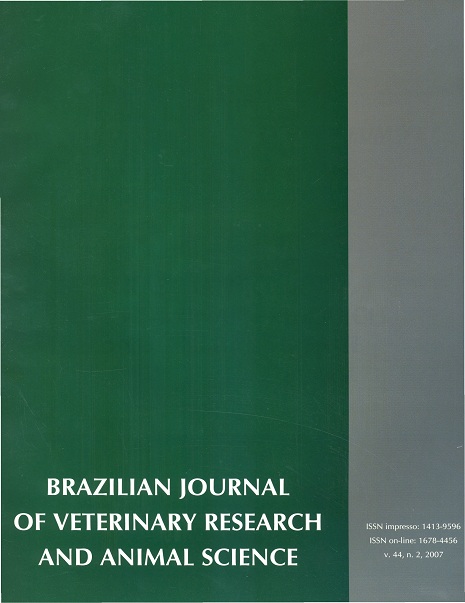Serum proteinogram in mules naturally infected by the Burkholderia mallei
DOI:
https://doi.org/10.11606/issn.1678-4456.bjvras.2007.26643Keywords:
Mules, Glanders, Serum proteinsAbstract
The Burkholderia mallei is the causing bacterium of glanders, illness of high morbidity and lethality for the equides, and also one zoonosis. Recently diagnostic in the Pernambuco and Alagoas States/Brazil, it comes decimating populations of equides in the Zone of Forest Region of these states, causing great damages to the sugar cane plantation activity that it uses such animals as traction. The objective this work was to investigate the proteins alterations caused by glanders. Had been studied ninety adult mules, of different races, destined to the work, proceeding from the sugar cane plantation region, Zone of Forest, in the Pernambuco State/Brazil. These were divided in three groups: G1: thirty animals with negative serology for glanders; G2: thirty animals with positive serology for glanders and without apparent symptoms and G3: thirty animals with positive serology for glanders and with apparent symptoms. The gotten results, referring the medium of the parameters studied respectively for G1, G2 and G3 had been: total serum protein 7.33; 7.73 and 7.46g/dl; albumin 2.57; 2.43 and 1.81g/dl; globulins 4.37; 4.86 and 5.64g/dl; albumin/globulins ratio 0.55; 0.47 and 0.34g/dl; alpha-globulin 1.06; 1.33 and 1.33g/dl; beta-globulin 1.10; 1.21 and 1.80g/dl and gamma-globulin 2.21; 2.32 and 2.51g/dl. It is concluded that the variations for the studied parameters were significant; the increase of the globulins characterizes an antigenic stimulus in the sick animals, as well as an inversion in the albumin/globulins ratio for the animals with apparent clinic in relation to the excessively animal ones. These findings could be considered in the diagnosis, prognostic and in future research that they aim at to study forms of immunization against this illness.Downloads
Download data is not yet available.
Downloads
Published
2007-04-01
Issue
Section
UNDEFINIED
License
The journal content is authorized under the Creative Commons BY-NC-SA license (summary of the license: https://
How to Cite
1.
Mota RA, Rabelo SSA, Cunha AP da, Pinheiro Júnior JW, Rego EW, Soares PC, et al. Serum proteinogram in mules naturally infected by the Burkholderia mallei. Braz. J. Vet. Res. Anim. Sci. [Internet]. 2007 Apr. 1 [cited 2024 Apr. 23];44(2):69-76. Available from: https://www.revistas.usp.br/bjvras/article/view/26643





